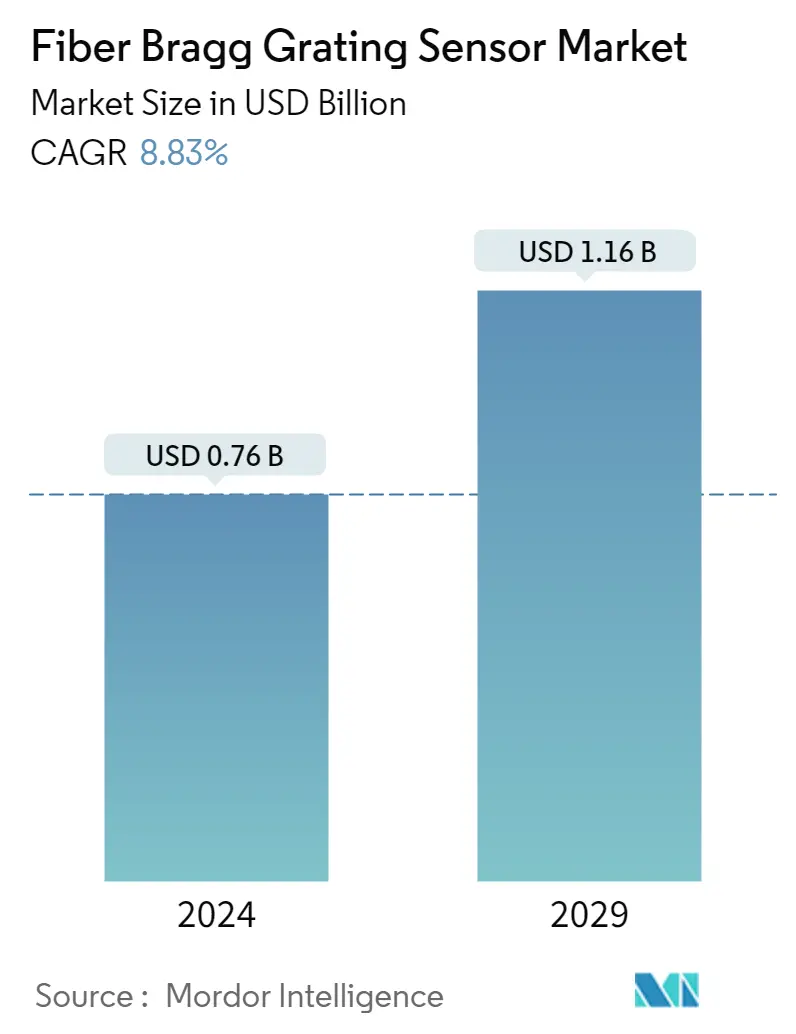Market Size of Fiber Bragg Grating Sensor Industry

| Study Period | 2019 - 2029 |
| Market Size (2024) | USD 0.76 Billion |
| Market Size (2029) | USD 1.16 Billion |
| CAGR (2024 - 2029) | 8.83 % |
| Fastest Growing Market | Asia Pacific |
| Largest Market | North America |
Major Players
*Disclaimer: Major Players sorted in no particular order |
Fiber Bragg Grating Sensor Market Analysis
The Fiber Bragg Grating Sensor Market size is estimated at USD 0.76 billion in 2024, and is expected to reach USD 1.16 billion by 2029, growing at a CAGR of 8.83% during the forecast period (2024-2029).
- Fiber Bragg grating (FBG) technology is becoming a popular choice for optical fiber sensors for temperature or strain measurements because of their simple manufacture, relatively strong reflected signal strength, and operational flexibilities.
- A periodic modulation of the refractive index of the fiber core along the longitudinal direction forms fiber Bragg grating sensors. Various sensing functionalities can be added to the optical fiber by carefully determining the structure. The wavelength-encoded nature of the output allows the use of the wavelength division multiplexing (WDM) technique by assigning each sensor to a different wavelength range of the available light source spectrum. As calibration is used to determine the mapping relationship between the physical quantity and wavelength and is one of the critical factors affecting the sensor's performance, such a feature favors the market's growth.
- Furthermore, a longer lifetime than other sensors is another major factor supporting the market's growth. According to Hindawi, a publisher of peer-reviewed, open-access scientific journals, the life-prediction model indicates that the estimated monitoring life of an FBG sensor in an unstressed condition is about 56 and 27 years under the stressful situations that fiber Bragg grating (FBG)-based steel strands are subjected to in their working environment.
- Owing to their intrinsic capability to measure a variety of parameters, such as strain, pressure, temperature, and many others, along a single fiber, their demand has been increasing across various end-user industries. Additionally, these multi-point sensing arrays of many relatively low-cost FBGs also provide great flexibility of design, making them ideal devices to be adopted for a multitude of different sensing applications.
- Fiber Bragg grating sensors have many advantages over traditional and structural monitoring devices in the building and aviation sectors. However, cost and technological limitations in some use cases are among the significant factors challenging their widespread adoption and growth.
- A notable impact of the COVID-19 pandemic was observed in the market studied. During the initial phase, the manufacturers faced difficulties in securing the supply of raw materials/components due to stringent lockdown measures, which disrupted the supply chain globally. However, with the condition normalizing and major end-user industries expanding their operations further, the demand for these sensors is expected to grow during the post-COVID period.
Fiber Bragg Grating Sensor Industry Segmentation
A Fiber Bragg Grating (FBG) sensor is a lightweight sensor that can be installed effortlessly. It features the multiplexing capability of sensing various parameters, like temperature, strain, load, pressure, etc., on different points on the same sensor cable.
The Fiber Bragg grating sensor market is segmented by type (temperature sensor, strain sensor, pressure sensor, and other types), by end-user industry (telecommunication, aerospace, construction & infrastructure, energy & power, mining, and other end-user industries), and by geography (North America, Europe, Asia-Pacific, Rest of the World).
The market sizes and forecasts are provided in terms of value in (USD) for all the above segments.
| By Type | |
| Temperature Sensor | |
| Strain Sensor | |
| Pressure Sensor | |
| Other Types |
| By End-user Industry | |
| Telecommunication | |
| Aerospace | |
| Construction and Infrastructure | |
| Energy and Power | |
| Mining | |
| Other End-user Industries |
| By Geography | |
| North America | |
| Europe | |
| Asia-Pacific | |
| Rest of the World |
Fiber Bragg Grating Sensor Market Size Summary
The Fiber Bragg Grating (FBG) Sensor Market is poised for significant growth over the forecast period, driven by the technology's advantages in temperature and strain measurement applications. FBG sensors, known for their simple manufacturing process, strong signal strength, and operational flexibility, are increasingly favored in various industries. The ability to encode measurements through wavelength division multiplexing and their longer lifespan compared to traditional sensors contribute to their rising demand. These sensors are particularly valued in sectors such as aerospace and construction, where they offer precise, remote, and lightweight monitoring solutions. Despite challenges like cost and technological limitations, the market is expected to expand as industries recognize the benefits of FBG sensors over conventional monitoring devices.
The market's growth is further supported by the increasing adoption of FBG sensors in aerospace applications, where they are used for monitoring aircraft components and ensuring structural integrity. The rise in aircraft production and fleet expansion, particularly in regions like North America, is anticipated to bolster demand. Additionally, the rapid industrialization in Asia, with countries like China and India leading the charge, is expected to drive market expansion. Government initiatives to support manufacturing and the growing civil aviation industry in these regions are also contributing factors. Key players in the market are leveraging strategic partnerships and technological advancements to enhance their product offerings, ensuring a competitive edge in the evolving landscape of fiber Bragg grating sensors.
Fiber Bragg Grating Sensor Market Size - Table of Contents
-
1. MARKET INSIGHTS
-
1.1 Market Overview
-
1.2 Industry Attractiveness - Porter's Five Forces Analysis
-
1.2.1 Threat of New Entrants
-
1.2.2 Bargaining Power of Buyers
-
1.2.3 Bargaining Power of Suppliers
-
1.2.4 Threat of Substitute Products
-
1.2.5 Intensity of Competitive Rivalry
-
-
1.3 Industry Value Chain Analysis
-
1.4 Impact of COVID-19 on the Industry
-
-
2. MARKET SEGMENTATION
-
2.1 By Type
-
2.1.1 Temperature Sensor
-
2.1.2 Strain Sensor
-
2.1.3 Pressure Sensor
-
2.1.4 Other Types
-
-
2.2 By End-user Industry
-
2.2.1 Telecommunication
-
2.2.2 Aerospace
-
2.2.3 Construction and Infrastructure
-
2.2.4 Energy and Power
-
2.2.5 Mining
-
2.2.6 Other End-user Industries
-
-
2.3 By Geography
-
2.3.1 North America
-
2.3.2 Europe
-
2.3.3 Asia-Pacific
-
2.3.4 Rest of the World
-
-
Fiber Bragg Grating Sensor Market Size FAQs
How big is the Fiber Bragg Grating Sensor Market?
The Fiber Bragg Grating Sensor Market size is expected to reach USD 0.76 billion in 2024 and grow at a CAGR of 8.83% to reach USD 1.16 billion by 2029.
What is the current Fiber Bragg Grating Sensor Market size?
In 2024, the Fiber Bragg Grating Sensor Market size is expected to reach USD 0.76 billion.

